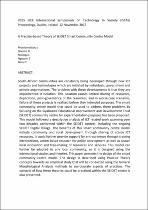JavaScript is disabled for your browser. Some features of this site may not work without it.
- ResearchSpace
- →
- Research Publications/Outputs
- →
- Conference Publications
- →
- View Item
| dc.contributor.author |
Phahlamohlaka, Letlibe J

|
|
| dc.contributor.author |
Dlamini, ZI

|
|
| dc.contributor.author |
Malinga, Andries L

|
|
| dc.contributor.author |
Ngobeni, Sipho J

|
|
| dc.contributor.author |
Mnisi, T

|
|
| dc.date.accessioned | 2018-04-11T09:16:53Z | |
| dc.date.available | 2018-04-11T09:16:53Z | |
| dc.date.issued | 2015-11 | |
| dc.identifier.citation | Phahlamohlaka, J. et al. 2015. A Practise-based Theory of SEIDET Smart Community Centre Model. 2015 IEEE International Symposium on Technology in Society (ISTAS) Proceedings, Dublin, Ireland, 12 November 2015 | en_US |
| dc.identifier.isbn | 978-1-4799-8282-0 | |
| dc.identifier.uri | 978-1-4799-8283-7 | |
| dc.identifier.uri | https://ieeexplore.ieee.org/document/7439411/ | |
| dc.identifier.uri | DOI: 10.1109/ISTAS.2015.7439411 | |
| dc.identifier.uri | http://hdl.handle.net/10204/10172 | |
| dc.description | Copyright: 2015 IEEE. Due to copyright restrictions, the attached PDF file only contains the abstract of the full text item. For access to the full text item, please consult the publisher's website. | en_US |
| dc.description.abstract | South African communities are constantly being developed through new ICT projects and technologies which are initiated by individuals, government and private organisations. The problem with these developments is that they are implemented in isolation. This isolation causes limited sharing of resources, duplication, poor-governance of the resources, and in worse-case scenarios, failure of these projects is realised before their intended purposes. The smart community centre model that could be used to address these problems by focusing on the Siyabuswa Educational Improvement and Development Trust (SEIDET) community centre for experimentation purposes has been proposed. This model followed a descriptive analysis of ICT related work spanning over two decades performed within the SEIDET context, including the ongoing SEIDET Digital Village. The benefits of this smart community centre model include community and rural development through sharing of scarce ICT resources. It could further provide support for entrepreneurs through training interventions, action-based research for policy development as well as spawn local innovation and free-sharing of resources and services. This model can further be adapted to any local community, as it is designed using the international studies and theories. This paper presents the design of the smart community centre model. The design is described using Practice Theory concepts towards an empirical study that will be conducted using the General Morphological Analysis methods to corroborate aspects of practices. The scenario of how these theories could be practiced within the SEIDET centre is also presented. | en_US |
| dc.language.iso | en | en_US |
| dc.publisher | IEEE | en_US |
| dc.relation.ispartofseries | Worklist;16333 | |
| dc.subject | Community Centre | en_US |
| dc.subject | Digital Village | en_US |
| dc.subject | SEIDET | en_US |
| dc.subject | Siyabuswa | en_US |
| dc.subject | Smart Community Centre | en_US |
| dc.subject | Village Operators | en_US |
| dc.subject | Practice Theory | en_US |
| dc.title | A Practise-based Theory of SEIDET Smart Community Centre Model | en_US |
| dc.type | Conference Presentation | en_US |
| dc.identifier.apacitation | Phahlamohlaka, L. J., Dlamini, Z., Malinga, L., Ngobeni, S., & Mnisi, T. (2015). A Practise-based Theory of SEIDET Smart Community Centre Model. IEEE. http://hdl.handle.net/10204/10172 | en_ZA |
| dc.identifier.chicagocitation | Phahlamohlaka, Letlibe J, ZI Dlamini, L Malinga, S Ngobeni, and T Mnisi. "A Practise-based Theory of SEIDET Smart Community Centre Model." (2015): http://hdl.handle.net/10204/10172 | en_ZA |
| dc.identifier.vancouvercitation | Phahlamohlaka LJ, Dlamini Z, Malinga L, Ngobeni S, Mnisi T, A Practise-based Theory of SEIDET Smart Community Centre Model; IEEE; 2015. http://hdl.handle.net/10204/10172 . | en_ZA |
| dc.identifier.ris | TY - Conference Presentation AU - Phahlamohlaka, Letlibe J AU - Dlamini, ZI AU - Malinga, L AU - Ngobeni, S AU - Mnisi, T AB - South African communities are constantly being developed through new ICT projects and technologies which are initiated by individuals, government and private organisations. The problem with these developments is that they are implemented in isolation. This isolation causes limited sharing of resources, duplication, poor-governance of the resources, and in worse-case scenarios, failure of these projects is realised before their intended purposes. The smart community centre model that could be used to address these problems by focusing on the Siyabuswa Educational Improvement and Development Trust (SEIDET) community centre for experimentation purposes has been proposed. This model followed a descriptive analysis of ICT related work spanning over two decades performed within the SEIDET context, including the ongoing SEIDET Digital Village. The benefits of this smart community centre model include community and rural development through sharing of scarce ICT resources. It could further provide support for entrepreneurs through training interventions, action-based research for policy development as well as spawn local innovation and free-sharing of resources and services. This model can further be adapted to any local community, as it is designed using the international studies and theories. This paper presents the design of the smart community centre model. The design is described using Practice Theory concepts towards an empirical study that will be conducted using the General Morphological Analysis methods to corroborate aspects of practices. The scenario of how these theories could be practiced within the SEIDET centre is also presented. DA - 2015-11 DB - ResearchSpace DP - CSIR KW - Community Centre KW - Digital Village KW - SEIDET KW - Siyabuswa KW - Smart Community Centre KW - Village Operators KW - Practice Theory LK - https://researchspace.csir.co.za PY - 2015 SM - 978-1-4799-8282-0 T1 - A Practise-based Theory of SEIDET Smart Community Centre Model TI - A Practise-based Theory of SEIDET Smart Community Centre Model UR - http://hdl.handle.net/10204/10172 ER - | en_ZA |






